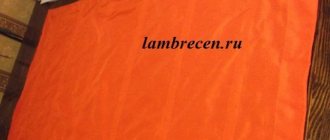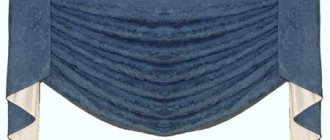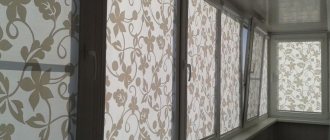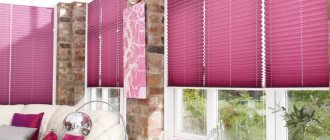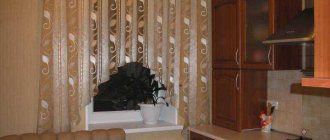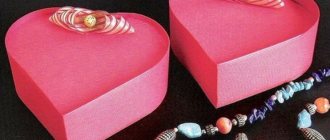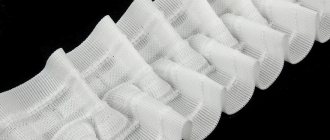Tailoring rules
Sewing curtains is not anything complicated; it is important to adhere to the basic rules when choosing fabric, taking measurements, have minimal cutting skills and be able to sew on a sewing machine.
To sew curtains yourself, you should follow the following procedure:
- Measure the length of the cornice. The cornice itself must be purchased before the fabric for sewing or the porters themselves.
- Measure the length of the curtain. If there is a radiator or convector under the window, the length of the panel must be no less than the heating equipment.
It must be taken into account that in addition to the main length there must be a margin for hemming the product, which must be at least 15 cm.
If drapery is planned, the width of the fabric should be 2-3 times the length of the cornice. The coefficient of static porters differs from the cornice by 1.2–1.5 times. For tulle this coefficient is 3.
The drapery will look beautiful if you calculate it as follows: divide the length of the curtain by the length of the cornice, for example, you get the number two, then there will be twice as much fabric as the length of the measured cornice.
Manual binding
Many people are faced with the need to hem things or textiles for the interior very rarely - only when necessary to adjust the length of clothing for themselves or their family. In such cases, it is unlikely that there is a sewing machine in the house. However, it is a mistake to think that without it you cannot cope with the task.
Progress
When you start sewing, you need to measure the correct length. To do this, take into account that the canvas, when it hangs and takes its final shape, may become longer. Shrinkage may occur when washed.
Therefore, before hemming the bottom of the curtain, you need to do the following:
- It is advisable to decate the fabric - perform a wet-heat treatment with an iron in order to immediately ensure shrinkage during the sewing process, and not end up with shortened curtains after the first wash;
- hang the curtain on the cornice with an uncut edge;
- wait until the fabric sags and reaches the correct length;
- pin the intended hem from the bottom and sides with pins; it is better to do this by weight due to possible unevenness of the floor or cornice;
- fix the correct length and remove for further work;
- hem along the entire hem line with a blind seam using one thread to match the curtain.
Impact on room size
It is important to remember that the color scheme can visually either reduce space or increase it. When choosing dark colors, the space decreases, and when choosing pastel, light colors, it visually increases.
The color of the curtains should stand out against the background of the main color of the room; it should be either lighter or darker than the color of the walls.
The placement of the pattern can also affect the size of the room. In particular, horizontal patterns tend to expand the room, while vertical ones will help create the effect of high ceilings.
When choosing silk for curtains, you should think about caring for them in advance. Natural silk curtains cannot be washed; they should only be cleaned yourself or with the help of dry cleaning services. In addition, silk tends to fade and such curtains will require additional lining.
The same rule should be followed for velvet.
Furniture fabrics look beautiful on windows if the overall interior of the room allows it, but for curtains made of furniture fabric you need to install a reinforced cornice.
Linen curtains made with the addition of lavsan are perfect for any kitchen. This fabric looks shiny and creates a feeling of lightness.
Transparent fabrics will help create the final look of the window, and tulle can complement the curtains. To sew tulle, fabrics such as Turkish chiffon, organza or guipure are well suited.
A little about choosing fabric
Before purchasing material, you need to weigh everything carefully. Decide in which room the curtains will be placed. The choice of material very often depends on this.
Fabric for curtains
For the kitchen, choose light curtains made of cotton or linen. They are completely natural and easy to care for. The cascade or arch style is perfect.
Attention! Synthetic fabrics are not used for the kitchen.
If curtains are needed in the bedroom, then it is advisable to choose more delicate and calm colors. Curtains should be very thick (blackout) to protect the room from direct sunlight. Such fabrics are also used for summer verandas. It is advisable to buy thick material without patterns. Curtains for a children's room should be made of bright and light colors. Fabrics for curtains that need to be used to decorate the living room are selected depending on the style of the room. Everything is suitable here, from ordinary velvet to double-sided linen, if the hall is made in folk style. You can draw a template for the window. This will help you choose which shape and length of curtains will look best in your home. In the store, it is better to consult with the seller and look at all the samples of curtain fabrics.
You might be interested in Features of patterns from Anastasia Korfiati: how to learn cutting and sewing
Direction of print on roll
What kind of curtains can you sew yourself?
Ideas for your own creativity can be drawn from the history of curtains: from animal skins with which caves were hung to the lush decorations of palace halls with luxurious tassels, draperies and multi-layered compositions.
Modern technologies make it possible to use new materials for curtains: wrinkle-resistant, non-flammable and not exposed to ultraviolet radiation.
Current fashion trends regarding curtains return to the old days, when great attention was paid to textile decoration.
Curtains with lambrequin
Curtains with decorative lambrequins are most often used in living rooms.
But, due to the fact that a lambrequin can not only decorate a window and give it a complete look, but also has quite practical functions: it hides cornices and curtain fastening systems - it can be used in all rooms.
The only condition is compliance with the style of the room in shape, choice of material and design.
Lambrequins with draperies are appropriate in the central room; they will create an atmosphere of comfort and luxury in combination with other interior items.
A rigid lambrequin frame - a gang made of fabric or plastic - can be used in the kitchen and bedroom.
Roman style
The highlight of Roman blinds is a specific fabric made from noble types of dense fabric: jacquard, satin, muslin with a large geometric pattern or without a pattern.
Practical Roman-style curtains in a modern apartment, designed in ethnic or minimalist style, look organic on the balcony, kitchen, bathroom and library, as well as in the living room and bedroom.
English style
For those who want to give their home an aristocratic spirit based on a combination of simplicity and nobility, English-style curtains will appeal.
The basis of such curtains is a smooth rectangular fabric.
Cords threaded through sewn rings are controlled by a lifting mechanism, thereby creating pleats: wavy, bow-shaped or puffed. The number of folds may depend on the size of the window opening or the preferences of the owners.
Classic
Classic curtains, made of two panels, are the simplest option, but also the most popular. Various methods of fastening: loops, ties, drawstrings, eyelets - make the classics not boring.
By making classic curtains double-sided, you can increase their functionality and decorativeness.
From two long, even canvases, you can use various technical devices to create style compositions:
- "hourglass";
- Japanese curtains;
- Italian curtains.
The location of the curtains determines the choice of fabric, which can be the simplest: linen or chintz and the most respectable: brocade, satin, velor, wool.
French curtains
The curtains, based on the traditions of lush France, are gathered along the entire length to form narrow scallops. Such curtains are sewn - “awnings” from soft, elastic fabrics: tulle, satin, silk, voile, chiffon, organza.
“Marquise” is a curtain for those for whom beauty in the interior is ahead of functionality.
Fabric consumption for curtains
The process of making curtains should begin with the purchase of fabric. Even if the choice is a simple model, it is necessary to correctly calculate the required amount of fabric for sewing.
The main parameters that you need to pay attention to are the width of the canvas and the direction of the pattern on it.
If there is a desire to make drapery in your plans, use the assembly coefficient (CF), which is expressed in the ratio of the cut to the width of the finished curtain. To determine how much fabric to buy in this case, you need to multiply the finished width of the curtain by the KS.
CS depends on the type of fabric:
- for curtains it is 1.7;
- for tulle with a pattern – 2;
- for tulle without a pattern - 3.
Tulle in roll
Textiles for sewing are sold in rolls. The standard width of a tulle roll is 2 m 80 cm. In order not to make mistakes in the calculations when purchasing tulle in a roll, you must measure the size of the cornice in advance and multiply it by the KS for this type of fabric.
This condition is only suitable for rooms with a ceiling height of no more than 2.5-2.6 m.
Curtains on a roll
The range of curtain fabric in rolls has three standard widths:
- 1.40 m;
- 2.80 m;
- 3m.
If the length of the intended curtain fits into the given width and the pattern is located from edge to edge, the fabric is calculated using the same formula as tulle: cornice width x KS (for curtains it is 1.7).
The calculation of the fabric will be different if the pattern is located along the edge and the width of the roll is less than the height of the future finished curtain.
When sewing several fabrics together, you should remember to match the pattern between them. In this case, you will need more fabric - exactly 1 repeat, that is, a completed fragment of the pattern.
How to hem with a sewing machine
Using a similar course of action as with manual blind hemming, it is necessary to carry out preparatory work .
This hemming method is best used if the fabric after washing is expected to begin to fray and needs to be hemmed. In this case, the tape will be a weak retainer, and manual work will be very labor-intensive. These types of fabrics require frequent stitch spacing, which complicates the process.
If you have a machine at home, then you can easily perform all types of sewing work, and even a not very experienced craftswoman will be able to figure out how to sew bias tape to tulle if necessary. With even, beautiful stitching, you can make decorative seams, which distinguish the product by its strength and reliability.
How to calculate fabric consumption for a curtain
Fabric can be calculated using three parameters. The main thing will be the calculation of length.
The first step is to find the distance from the cornice to the required end mark - the floor or window. This will be the finished length of the curtain. The length of the curtains can be optional:
- not reach the floor 1 cm, the longest models;
- reach the floor with a train of up to 10 cm;
- reach the window sill line;
- located 10 cm below the window sill.
Calculation of fabric width.
Material consumption for curtain widths is calculated taking into account three indicators:
- cornice length;
- material assembly factor;
- seam allowances.
First you need to measure the working length of the supporting rod of the cornice. The cornice protrudes about 15 cm beyond the window so that the curtains can be moved freely. The resulting figure is multiplied by the fold coefficient.
Uniform, correct drapery is related to the thickness and structure of the material.
The thinner and lighter the fabric, the higher the number will be acceptable. For example, for veil and chiffon, the fold coefficient will be from 2 to 4, for thick fabrics 1.5-2.
General recommendations for hemming curtains
The need to shorten the curtains can arise at any time: for example, if you decide to hang long curtains from the bedroom in the kitchen, or after moving to a new place it turns out that the fabric is bunched up on the floor. You can shorten the fabric in 2 ways: cut or bend.
Not everyone likes long curtains
Important! Before cutting off an extra piece, you should think carefully about whether you will regret it.
Before you start, you should familiarize yourself with some general rules:
- Before starting work, you need to let the curtains hang. This will help straighten the fabric and get more accurate measurements. You need to wet the fabric and hang it on the window without wrung out for 3-4 days;
Before work, the fabric must be stretched as much as possible.
- It is better to fold thick, heavy fabric from the bottom once, thin fabric - 2-3 times;
- The color of the thread must completely match the color of the fabric. If the material is thin, the thread should be lightweight, otherwise it will be visible;
- Pins used for pinning fabric should be thin and not leave noticeable holes in the fabric;
- At the beginning and end of the line there is no need to tighten it, it looks ugly;
- How to hem tulle at home without a machine or organza? These fabrics can be singed: when melted, the threads will seal the edge. But this option requires a lot of dexterity, as it is easy to burn the fabric in a few seconds or leave an unsightly black edge;
Curtains that sweep the floor look ugly
- If the fabric is thick, for example, blackout, its edges may curl after folding. To prevent this from happening, you need to hide a small weight inside the gate. If the weighting material is hidden by the manufacturer, the curtains will have to be shortened at the top;
- If the fabric frays a lot, it is worth additionally stitching the edge with a zigzag seam;
- You can sew a lace ribbon or braid in place of the bend - this will make the curtains more elegant or hide a small mistake;
- Before starting work, it is worth practicing on a small piece of fabric to understand how the material behaves.
You might be interested in: How to properly sew lace to the bottom of a dress
The braid around the edge looks elegant and can liven up curtains
Measurements
Before you start measuring, it is important to let the fabric stretch and sag - only then can you remove the fabric and start measuring. You can measure fabric only on a smooth surface, for example, on a clean floor. If it wrinkles a lot, you should iron it in advance.
Important! Sometimes the length of the curtains is much longer than necessary (for example, the length of the fabric is 3 meters with a room height of 2.5). In this case, it is worth removing exactly the extra piece, then starting measuring.
It is believed that the length of the curtains should be 5-10 cm less than the height from the ceiling to the cornice, otherwise the fabric will reach the floor. When hemming, add 8-14 cm to the resulting number, depending on the fabric and the desired shape. For example, if you need to tuck the material twice, you should leave more space, if only once, or use less braid.
Measurements must be fairly accurate
It is also worth considering the desired shape of the curtains and location: for example, in the kitchen, many people hang curtains up to the window sill, in the living room - up to the floor.
Trimming
You should only cut fabric if there is a lot of it. If the curtains are 10-20 cm longer than required, it is better to fold them and hem them, then, if necessary, the length can be returned.
Cut with large, sharp scissors without lifting the fabric. To ensure an even cut, you should draw a line in advance, cut as much material as possible at a time and do not lift the fabric by hand.
The material should be cut off if there is too much excess fabric
Drawing creation and initial work
Before you start sewing, you need to find or describe your own curtain patterns, select sketches, patterns, more suitable materials and solve other problems. All size parameters must be noted on the pattern.
Templates you make yourself can turn out just as good as store-bought ones. It is important to take measurements from the window correctly.
The style of the curtains should fit completely into the overall design of the room and not look bulky or pretentious. Below you can read step-by-step instructions for sewing curtains with your own hands.
Sewing curtains with your own hands: step-by-step instructions for connecting panels
The curtain making process consists of several steps:
- connection of two elements;
- ironing;
- stitching on a sewing machine;
- cutting the basting;
- smoothing the elements.
The process of sewing curtains with your own hands is described in detail below.
How to sew curtains: patterns
Like any work, sewing curtains begins with creating a pattern. You can find it on the Internet or draw it yourself. It is important to indicate all dimensions (length, width, etc.), choose the color of the fabric, the number of folds, and the density of the products.
This is the most critical stage, since the type of product depends on it.
The second stage of work is cutting
Before working with the material, it is advisable to wash it so that it shrinks first. Next, dry the fabric and iron it on the inside. Prepare tools for work:
- textile roller;
- disappearing marker;
- tailor's pins;
- tape measure;
- ruler.
When cutting elements, you need to be guided by the indication of the grain thread so that the curtain does not change shape during use. Cutting is done from large canvases:
- lay the fabric on the surface with the inside facing up;
- place the pattern elements on the material;
- circle them with a marker, not forgetting to leave allowances (10 cm on top, 5 cm on the side).
Side edge finishing
Basically, the edges of the material are processed manually; this is even better for plain fabrics with a smooth structure - the stitches on the outside will remain invisible. The main thing is to grab only one thread of the main fabric with a needle.
Thicker stitches will be visible later.
We sew the curtain tape
Stages of sewing curtain tape:
- prepare the curtain, bend the top edge to the inside and iron it, the fold size is 2-3 cm;
- attach the curtain braid to the upper edge of the curtain (from the inside), making an indent of 1 cm from the edge;
- pull out the laces;
- bend the edges of the tape by 2-2.5 cm;
- stitch each edge using a machine.
Bias trim
You can hem the curtain using bias tape or tape cut from a material in a color contrasting with the main fabric. This finishing will emphasize the exclusivity of the product; the main thing is to choose the appropriate edging material.
To process the edge of the fabric with bias tape, you will need a sewing machine and a special foot, which can be bought in stores with sewing equipment. Having measured the required length of the curtain, cut off the excess material along the line, leaving only 5 mm. The edge of the fabric is inserted inside the bias tape and carefully stitched, trying to place the seam as close to the edge of the tape as possible.
Treat the edge of the curtain with edging material as follows:
- An edging strip is cut out from a contrasting color material. The width of the strip depends on the artistic imagination of the craftswoman, but you should not make the edging too wide, otherwise the product will look tasteless.
- The strip of material is folded in half and ironed to secure the fold.
- The upper and lower edges of the strip are folded inward by 1 cm and ironed again.
- The edge of the curtain is inserted between the two layers of edging so that at least 1 cm of the main fabric is inside. Baste and then sew with a machine seam or zigzag.
We recommend: Learn how to beautifully fold paper napkins on a holiday table using diagrams
To make the finished product look harmonious, the sides are also trimmed with finishing material.
Sewing a lambrequin for curtains
Decorating curtains with a lambrequin is to the liking of many housewives and it is not at all necessary to purchase it in a store, because it is very easy to sew it with your own hands.
But this will require good and correct patterns so that the product can be sewn easily and not adjusted during the process.
In addition, the choice of material and decorative elements is no less important. Most often, curtains and lambrequins are made from the same material.
But no one can stop you from imagining and experimenting. A great idea for decorating a window would be to use plain curtains and a lambrequin with floral colors.
The main thing is not to disrupt the integrity of the interior balance.
Next, when sewing curtains, be sure to consider the following points:
- When the material is prepared, the correct calculation can be made. To make a lambrequin it will take about 1/5 (1/6) of the entire length of the purchased material, plus a reserve for hemming.
You can also make curtain tiebacks yourself.
- the presence of folds on the curtain and their quantitative composition must be thought out in advance, where they will be marked with braid.
- Make the fold of the fabric at the top of the curtain in the form of a pocket for a wooden strip, slightly larger in size. To process the pocket, you should use a reverse stitch.
- The edge of the lambrequin with marked and fixed folds should be carefully stitched along the edge and secured, ironing thoroughly with an iron.
- To decorate the lambrequin, use fringe, beads, and ribbon flowers. But be sure to take into account the density of the fabric.
Double curtains
They are 2 canvases, located one above the other, and the top one can be collected with a brooch or tie in the center, both at the bottom and 40-50 cm from the cornice. One or both parts can be complemented with decorative magnets, tassels, ribbons or other tiebacks.
Double curtains are not inferior in pomp to lambrequins, but are much more practical and easy to care for, so they are becoming increasingly popular. They are mounted on a cornice of 3 rows, based on the fact that on one strip there will be a curtain, and on 2 and 3 along the canvas, each of which moves separately and freely. A double curtain can be hung alternately in 1 row, for example, beige on 1 hook, brown on the other, beige on the third again.
To decorate your living room with multi-layer curtains, you can use the following combinations of fabrics:
- plain in contrasting color;
- 1 of the canvases can be with a pattern;
- companion fabrics with identical patterns.
Light and dense materials are suitable for sewing double curtains in the living room with your own hands, but you should keep in mind that it is difficult to work with silk and satin without experience. During manufacturing, the elements are cut out separately, and each can have a different shape and length. The top, and sometimes both panels, are draped with gathers or folds. These curtains are attractive because the layers can be swapped to create different decor options.
You may also be interested in: How to sew tulle - instructions and video
How to make Roman style curtains?
Roman blinds are very popular, so very often housewives are interested in the question of how to sew a Roman blind.
First of all, you should remember that these Roman blinds are sewn taking into account that they cover the window tightly enough.
For this reason, before purchasing the required amount of material for sewing curtains in the Roman style, you should accurately measure the window opening, and add 5 cm to the resulting width on each side for allowances.
In addition, the length of the fabric should be increased by 12 cm.
The fabric for making curtains in the Roman style can be chosen to suit your taste. Today, fabric manufacturers offer consumers a wide variety of fabric options. Any housewife can choose the fabric to her taste without any problems.
Using chalk or soap, mark the lines along which the curtains need to be hemmed.
An adhesive tape is attached to the beam, and a similar tape is also attached to the upper edge of the curtain. At the point of fastening, the curtain fabric is attached to the beam.
After this, the lower side is ironed and hemmed. The next step is hemming the finishing border. The rings are attached to the curtain using wide stitches. Then the curtain is attached to the beam.
The final stage of making curtains is threading the cord into the rings, after which the cord is pulled together and the excess ends are cut off.
The resulting curtains look solid and expressive.
Gatherings and pleats
How much fabric should I take for the window? It is believed that if the curtain is to be gathered, the width of the canvas should be 2-2.5 times wider than the cornice. However, if there are both curtains and curtains on the window, it is enough to take 1.5 times more fabric. The same proportions are recommended if the fabric has a large pattern, which will not be visible when the fabric is pulled tightly together. For curtains with eyelets, fabrics are taken 2 times the width of the cornice.
The top edge of the curtains is folded using curtain tape, which gives the living room a festive look. Unlike assemblies, they have a more regular shape and are located directionally. The upper edge of the fabrics is treated with adhesive interlining or edging 7-10 cm wide, after which the folds are fixed on the wrong side and stitched to the height of the interlining. Do not make markings with abrasive crayons; traces of them may remain on the fabric even after washing.
The most elegant types of folds are:
- Inverse (counter). On the front side, the folds of the fabric are directed towards each other.
- One-sided. They are laid in one direction at the same distance. They can be directed from both sides to the middle of the canvas, where the central - counter fold is located.
- Bow ones. On the front side, the folds of the fabric are directed in different directions. They are placed at equal or different intervals, sometimes without them at all.
- Shells. They have a smaller volume and are suitable for bright fabrics. They are stitched from the front side to the width of the beading at a distance of 15 cm from each other and a dense gasket is inserted inside the resulting cavity.
You may also be interested in: Creating a swag on a curtain tape with your own hands
Designers advise not to deepen the folds by more than 14-20 cm, and the narrower the window, the smaller they should be. Decorative braid or curtain tape is attached to the upper part. If it is loose, steam it. It may be made from fabric that shrinks.
Folds are used in the manufacture of lambrequins. It should be no more than 1/5 of the curtains in height. Sometimes folds are assembled by hand, without using a sewing machine. If the width of the fabric is not enough, grind the fabric down and make sure that the seam is inside the fold. It should be borne in mind that the denser and heavier the material, the worse it drapes. Rigid lambrequins with complex assemblies are made using special templates. It is difficult to do it yourself with high quality without special skills; it is better to entrust it to the masters.
Sewing curtains in English style yourself
Curtains made in the English style look elegant, light and airy. Curtains of this type are perfect for any room; the use of this interior element allows you to add a certain zest and uniqueness to the design of the room.
There is nothing complicated in the process of sewing this type of curtain and almost any housewife with sewing skills can sew such curtains.
To make curtains, you should prepare the required amount of satin, natural muslin and satin ribbon.
When calculating the length of curtains, you should take into account the parameters of the window opening. When preparing the material, be sure to take into account the material used for folds and hemming.
On the curtain canvas you should mark the places where you plan to sew satin ribbons. After this, the prepared ribbons are folded one centimeter on each side, ironed and hemmed. The ribbons are pinned to the main fabric and sewn on a sewing machine.
At the final stage, the upper edges of the satin ribbons should be secured. After the entire curtain is ready, its lower edge should be hemmed and thoroughly steamed.
In order to decorate the curtain, you can place several additional satin ribbons.
Sewing simple and beautiful curtains - step-by-step instructions
If you do not want to create complex and binding compositions, you should opt for simple designs that can be decorated with delicate bows. Very often, such curtains are used to create a cozy interior in the kitchen.
For this reason, very often you can hear from housewives the question of how to sew simple and beautiful curtains for the kitchen with your own hands.
Simple curtains can have an unpretentious appearance, but they will be both beautiful and ideal for decorating a kitchen space. If you want to decorate the curtains, you can additionally use a variety of decorative elements for this purpose, which will give the curtains uniqueness and add a special zest to the interior.
The fabric for making canvases should be chosen with a width that corresponds to the window opening in the room.
Types of seams
When sewing curtains, mainly two seams are used:
- Roller - narrow overlock stitch, with a minimum stitch frequency.
- Moscow - hemmed edge seam with a closed cut, performed in two lines of which, visible on the front side, the result is only one.
Fabric hem
To ensure that the result does not disappoint, it is very important to correctly fold the fabric, according to the rules:
- A double hem makes the edge of the curtain even, but it is not suitable for curtains with interfacing.
- Basting should be done with long stitches to avoid deformation.
- Before ironing the hems, it is better to secure the curtain with pins.
- Before hemming the bottom edge of the curtain, let it hang for a couple of days.
- Hemming can be done using a sewing machine with a zigzag stitch, adhesive tape, or by hand using a hem or blind stitch.
Curtains with hinges
Curtains with hinges are an option for framing windows in a studio apartment of a young family, a kitchen space or a nursery. The peculiarity of this type of curtain is that, apart from the fabric, no additional devices are required.
A hinged curtain is a processed fabric with decorative loops.
A step-by-step master class will help you understand the intricacies of this simple process:
- Cut out 2 pieces of fabric using the above cutting technology.
- Sew the upper part of the fabric, preparing a piece - a strip of fabric with a length equal to the width of the curtain and a width of 10 centimeters.
- Glue non-woven tape onto the strip.
- Hem the curtains at the top and bottom, turning the edges inside out twice.
- Determine how many loops you will need, taking into account that their standard width is from 6 to 7 cm.
- Prepare the blanks, taking into account that the width of each blank will be equal to: 6*2+1.5=13.5 cm.
- Fold each piece in half, wrong side up.
- Sew, retreating from the edge 1.5 cm.
- Turn right side out and fold so that the seam is at the back.
- Make markings on the canvas for the location of the loops.
- Place the loops on the front side of the fabric with the cuts facing up and secure with pins.
- Place a strip of fabric prepared for facing on top and stitch along the top line, retreating 1.5 cm from the edge.
- Fold the strip to the wrong side, iron and baste from the wrong side.
- Thread the loops onto the cornice.
How to hem curtains made of light fabrics?
Thin fabrics – chiffon, organza, nylon, which are popularly called “tulle” – create the impression of weightlessness of the window composition. It seems that there is nothing easier than cutting and hemming such a light curtain. However, this work also poses many difficulties.
The nylon fabric slides, so cutting a straight edge is very difficult. It’s good if the tulle is decorated with a simple symmetrical pattern. In this case, you need to fold the curtain in half, matching the fragments of the pattern, and secure it with pins. If the curtain is wider than 3 m, you can fold the fabric into 4 layers and also secure with pins. After this, measure the required length and cut the fabric with sharp scissors, leaving only 1–1.5 cm for hemming.
A curtain without a specific pattern is more difficult to cut. The length is measured in several places, notches are made with chalk or pins, and only after that the excess material is carefully cut off. This is exactly the case when “measure twice, cut once.”
For hemming, two types of seams are used: “Moscow” and “zigzag”.
"Moscow"
The Moscow seam, or “American” in other words, is used for hemming thin fabrics cut along an oblique line. To get this finish, you need to do the following work:
- bend the edge of the fabric by 5 mm and iron it;
- sew the hem, retreating from the edge of the fabric no more than 3 mm;
- cut off excess fabric as close to the stitching as possible;
- bend the material inward one more time by 5 mm;
- lay a line so that it coincides with the already made seam.
If you carry out this processing of the material correctly and carefully, one machine seam will be visible on the front side, and two lines will be visible on the back side.
Zigzag
The zigzag stitch is found on all modern sewing machines; it is usually used to process internal seams. This stitch is also useful when shortening a light curtain.
- Before starting work, you need to determine the optimal width and length of the stitch so that the hem is smooth, beautiful, and the connection is strong.
- The edge of the fabric is folded 1 cm and the fold is fixed with an iron.
- The fold of the fabric is processed with a zigzag.
- Excess tulle is trimmed with small sharp scissors.
Some craftswomen do not hem nylon curtains, but singe them, trying to seal the edge of the product. This requires some skill, otherwise you can burn the product.
Every housewife with minimal experience in sewing can shorten and hem a thick curtain or thin tulle at home. To do this, you don’t need to have a sewing machine; you can do the job by hand. The main thing is desire and patience.
How to sew curtains with ribbon
Curtains on ribbons specially designed for draping and hanging on curtain hooks are the simplest option for window decoration. Simplicity of design is in no way related to decorativeness, which is ensured through the selection of fabric, trim and accessories.
First of all, you need to measure the width of the cornice and the height from the floor to the cornice, and take into account the fabric for the top and bottom trim. Create a pattern and prepare two identical fabrics.
The curtain tape is sewn according to this algorithm:
- Lay out the fabric with the wrong side up, and apply the tape also with the wrong side up on the top edge of the fabric.
- Carefully fold the top edge 2-3 cm, catching the edge of the braid.
- At a distance of half a centimeter from the fold, stitch the top of the ribbon, then the bottom of the ribbon.
- Release the cords, fold the side edges of the fabric 1.5-2 cm over the braid and stitch.
- Iron the finished curtains, observing the temperature conditions.
- Tighten the cords, forming even folds across the entire width of the curtain.
- You can do without additional costs and hang the curtain from the loops located on the tape on the hooks located on the cornice.
- The classic version of curtains with hinges can be diversified with interesting hooks. You can make them from soft toys, artificial flowers and decorative ribbons.
Embroidery will turn a simple curtain into a designer one.
The work invested in creating a cozy family nest will be justified by the admiration and respect of loved ones.
How to shorten curtains without hemming
Sometimes it is necessary to make curtains shorter without cutting off excess fabric. In this case, you can use some tricks:
- Gather the curtains into folds. Folds can go on the sides (English curtains) or along the entire length (Austrian curtains). The latter are done as follows: a horizontal line is drawn across the entire width of the fabric at a distance from the bottom. From this line, parallel lines are drawn at equal distances to the edge of the material. Then the curtain is hung on the curtain rod and the fabric is pierced along vertical lines, collecting folds - by pulling the thread, you can adjust the height of the folds and their appearance.
By gathering the curtains in folds, you can maintain the length of the material
- You can sew a narrow curtain tape at the back along the vertical lines. This is a more durable option that can hold heavy fabrics and can be used to constantly adjust the height.
- Collect in a roll. Light tulle curtains that drag along the floor can be rolled into a roll and carefully hemmed with thick thread;
- Magnets for curtains. The curtains are gathered from the bottom and secured between two attractive magnets. The second option is to bend the edge of the curtain and fix it to the wall. Magnets can be discreet or bright, which will become excellent accessories. When purchasing, it is important to remember that only strong magnets can support heavy material;
You might be interested in this: How to use old jeans to sew something
Magnets are extremely convenient and easy to use
- Sew with large stitches or pin. If you need to assemble the curtain for a short time, for example, for a photo shoot, you can carefully sew the edge with large stitches, and then pull out the thread.
And, of course, you can leave the curtains at the existing length. Curtains that trail along the floor are quite popular today: they look impressive and soften an overly serious interior.

